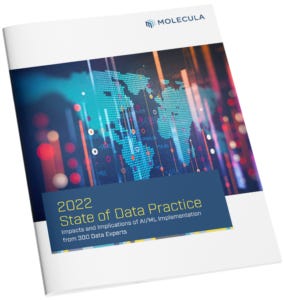📝 Guest post: 2022 State of Data Practice Report - Key Findings Revealed*
In this Guest post, our partner Molecula introduces the 2022 State of Data Practice Report and reveals why many companies still struggle to implement AI/ML successfully.
What the report covers:
Top 3 roadblocks to successful AI/ML implementation
What it takes to get an AI/ML model from an idea to production
Workarounds, time-saving hacks, causes of technical debt, and more
At Molecula, we asked 300 data practitioners across a wide swath of industries, roles, and experience levels about implementing advanced analytics and AI/ML in order to better understand the organizational and role-based implications and impacts.
Key Findings
Data practitioners overwhelmingly agree that their organizations are effectively using data and that advanced analytics will be very transformational in their industry in the next 3-5 years.
Organizations are more aligned than ever, but struggling to identify the right tools to support production. Making changes or updates to established production models was the most significant challenge.
Data wrangling tasks, especially preaggregation, are underlying problems that limit the implementation of AI/ML.
Advanced Analytics and AI/ML in your Organization
Most data practitioners believe that advanced analytics and AI/ML will be very transformational to their industry (65%) over the next 3-5 years (Figure 1).
Despite positive sentiment about their organizational data strategy, the majority of data practitioners had yet to work with production models in their current organization (61%).
The largest group of organizations were just starting to develop and build AI/ML models (24%), followed by those that had models developed and were working toward production (23%).
Those that had worked with production models had only been doing so for a couple of years (22%), very few for five or more years (2%).
Next, we asked data practitioners how much time it would take to get an AI/ML model from an idea to production at their organization today.
Results confirmed that timelines are long.
Two-thirds of data practitioners reported that the process took seven months or more (67%) (Figure 3). View the full report→
We asked data practitioners to rank the top three reasons that limit AI/ML projects from being fully implemented or considered successful in their organizations (Figure 4).
Making changes or updates to an established production model’ was most often selected as the top challenge (14%).
C-level data practitioners selected this as the top challenge 33% more often than other data practitioners.
In the full report, data practitioners answer the question: “If you could tell your leadership one thing about Advanced Analytics and AI/ML, what would it be?”
A: “Try to listen to the engineers, instead of making business decisions which hurt the company in the long term.” – Senior Data Scientist
A: “I would tell them that everything takes time. That's their problem, they want it fast but it takes time.” – Senior Data Analyst
We then asked data practitioners to rank the top three reasons that best explain why advanced analytics and AI/ML models don’t meet business needs (Figure 5).
The reasons most often ranked in the top three were:
‘Model performance was not as expected’ (47%)
‘There were unrealistic expectations from the business about the potential impact of the models’ (43%)
‘The model does not integrate into our existing tech architecture’ (40%).
“Until organizations are able to extract more value than they put into implementing Advanced Analytics and AI/ML projects, they will not truly reap the rewards of production.” – 2022 State of Data Practice Report
Download the 2022 State of Data Practice Report to view key findings 4-8.







